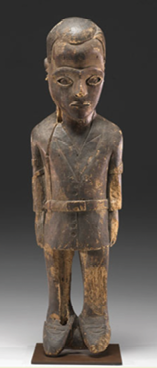(GIN)—A fierce tug of war is underway between a U.S. museum and a Congolese gallery over a statue depicting the angry spirit of a Belgian officer beheaded during an uprising in Congo in 1931.
An image of the statue of Maximilien Balot, a colonial administrator, is claimed by the Virginia Museum of Fine Arts which is accused of stonewalling requests for a loan of the artifact to White Cube, a gallery in Lusanga backed by artists collective known as the Congolese Plantation Workers Art League in the Democratic Republic of the Congo.
The dispute has developed into a legal altercation after White Cube sought to raise funds by selling digital images of the Balot statue—known as non-fungible tokens or NFTs—resulting in accusations from the Viriginia Museum of a breach of copyright.
A spokesman for the Virginia museum said the “image was lifted directly from the museum’s website without permission, which violates our open access policy and is unacceptable and unprofessional.”
Renzo Martens, a Dutch artist and director at the White Cube, said: “We have downloaded the image from the internet as there is no other material made available by the Museum. We do not have copyright for the image—we use it under the doctrine of fair use.”
Balot was hacked to death during a revolt over the rape of the wives of men who had refused to work at a palm nut plantation in Lusanga.
The brutal Belgian retaliation that followed led to the revolt of the Pende people, one of the last significant rebellions against colonial rule before independence was secured three decades later. A statue was carved of Balot’s angry spirit in an effort to control it, experts say.
The statue was purchased in 1972 by Herbert Weiss, an emeritus professor at City University of New York while he was on a field trip near Lusanga, formerly known as Leverville after William Lever, the founder of Unilever. It has been on loan to the Reitberg Museum in Zurich since 2016.
The disagreement highlights the tensions between Western institutions displaying artifacts dating from the colonial era and the countries from where artistic and cultural works were taken.
The Virginia Museum of Fine Arts has 300 employees and an annual revenue of $21.3 million, while the White Cube was established by former plantation workers and is supported by fundraising by the artists collective.
Cedart Tamasala and Matthieu Kasama, two representatives of the artists’ collective, visited the Museum in February 2020 where they first asked for a loan of the statue. Tamasala said bringing back the statue even if only for a loan was an important way for Africans to reconnect with their past.
“The lost item, the Balot sculpture, was made to control the spirit of dead Balot, which could wander and harm the ethnic Pende or their surroundings. Currently, what role does she play?” he asked.
“It is objectified and classified or imprisoned—a sterile museum with so many objects looted in Africa, with no other purpose than to make money or educate their own population.
“We have the strong impression that they are not ready to lend it to us; it can be lent to a museum in Switzerland or elsewhere, but not to a museum in the plantation for the resistance against which, among other things, it was designed and sculpted.”
Aiming to highlight links between Western museums, looted objects, and the places from which those pieces were taken, the group recently produced a documentary series called “Plantations and Museums,” which examines connections between plantation labor and the funding of Western institutions.
The documentary can be seen online at https://www.humanactivities.org/en/balot/













